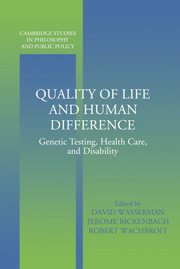Book contents
- Frontmatter
- Contents
- Contributors
- Acknowledgments
- Introduction
- 1 Assessing Quality of Life: Clinical versus Health Policy Uses
- 2 Predicting Genetic Disability while Commodifying Health
- 3 Preventing Genetically Transmitted Disabilities while Respecting Persons with Disabilities
- 4 Disability, Ideology, and Quality of Life: A Bias in Biomedical Ethics
- 5 Values for Health States in QALYs and DALYs: Desirability versus Well-Being and Worth
- 6 Preventing the Existence of People with Disabilities
- 7 Where Is the Sin in Synecdoche? Prenatal Testing and the Parent-Child Relationship
- 8 The Social Context of Individual Choice
- 9 Disability and Health Systems Assessment
- Index
5 - Values for Health States in QALYs and DALYs: Desirability versus Well-Being and Worth
Published online by Cambridge University Press: 03 December 2009
- Frontmatter
- Contents
- Contributors
- Acknowledgments
- Introduction
- 1 Assessing Quality of Life: Clinical versus Health Policy Uses
- 2 Predicting Genetic Disability while Commodifying Health
- 3 Preventing Genetically Transmitted Disabilities while Respecting Persons with Disabilities
- 4 Disability, Ideology, and Quality of Life: A Bias in Biomedical Ethics
- 5 Values for Health States in QALYs and DALYs: Desirability versus Well-Being and Worth
- 6 Preventing the Existence of People with Disabilities
- 7 Where Is the Sin in Synecdoche? Prenatal Testing and the Parent-Child Relationship
- 8 The Social Context of Individual Choice
- 9 Disability and Health Systems Assessment
- Index
Summary
INTRODUCTION
In cost-utility analysis of health interventions, and in burden-of-disease measurement, health problems of different degrees of severity are assigned numerical scores on a scale from zero to unity. The scores are used to weight life years in calculations of quality-adjusted life years (QALYs) and disability-adjusted life years (DALYs). The scores are controversial for a number of reasons. One is that they may be seen as a devaluation of the lives of people with chronic illness or disability. While this is not necessarily the intention of the constructors and advocates of QALYs and DALYs, it is certainly the way in which people with chronic illness or disability tend to perceive these approaches (Dahl, 1992).
I believe some of the controversy over health state scores could be avoided if those who develop and use them could be both more clear and more restrictive about what the scores are supposed to mean. More specifically, I think there is a need to distinguish between the worth of a person with a given problem, the well-being associated with that problem, and the desirability of avoiding or getting rid of the problem. These are three separate issues. It is a serious mistake to think that they can be measured in the same way or expressed in one single index.
I discuss each of these concepts in the following. Then I explain a little more about QALYs and DALYs and show how the advocates of these measures have failed to clarify their meaning in the past.
- Type
- Chapter
- Information
- Quality of Life and Human DifferenceGenetic Testing, Health Care, and Disability, pp. 125 - 141Publisher: Cambridge University PressPrint publication year: 2005
- 1
- Cited by



